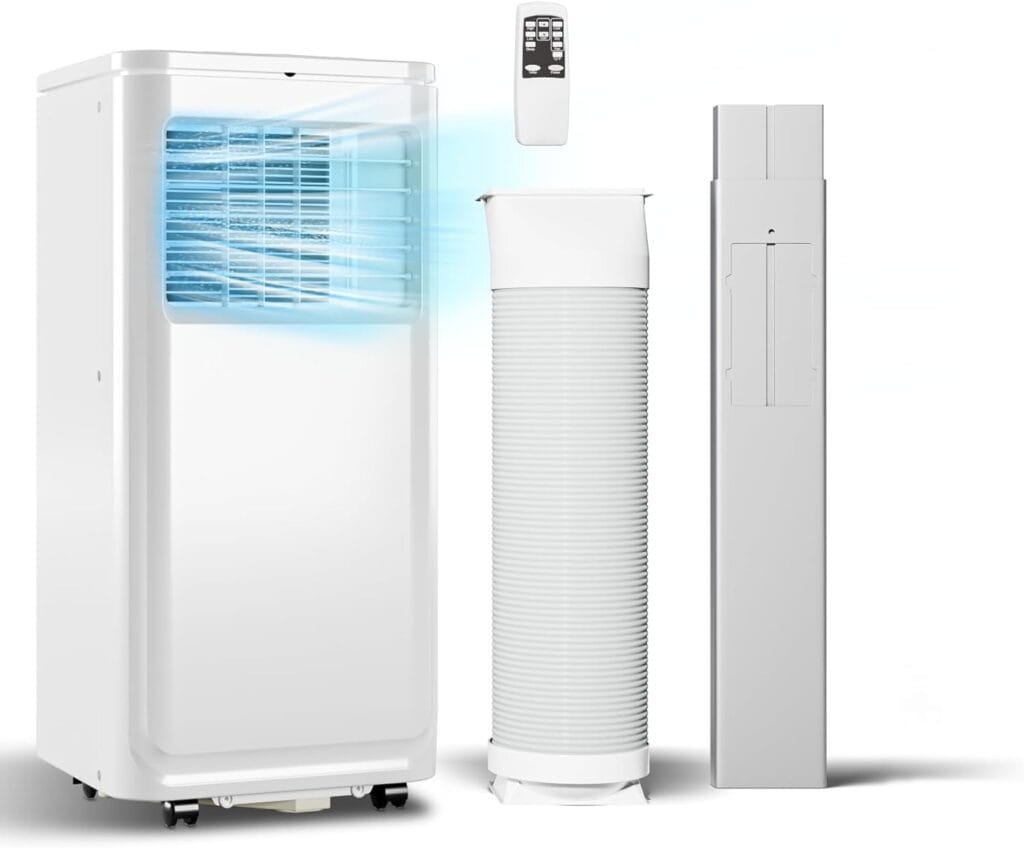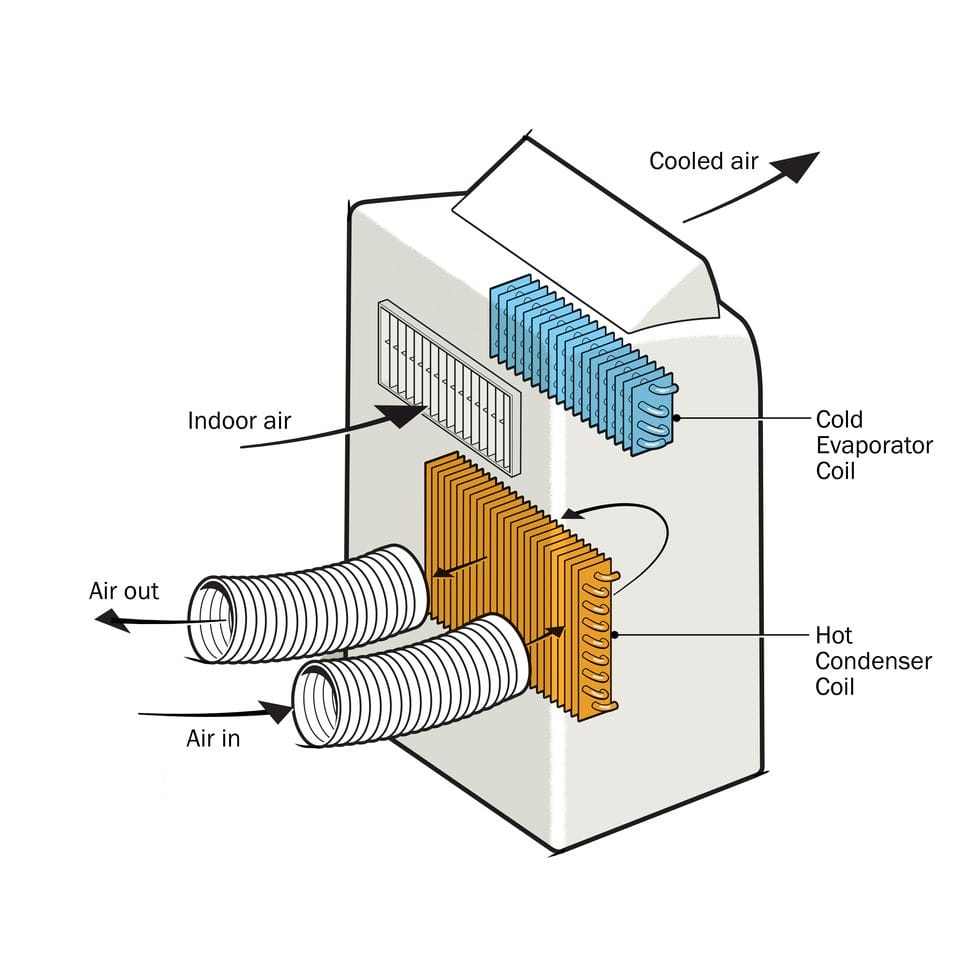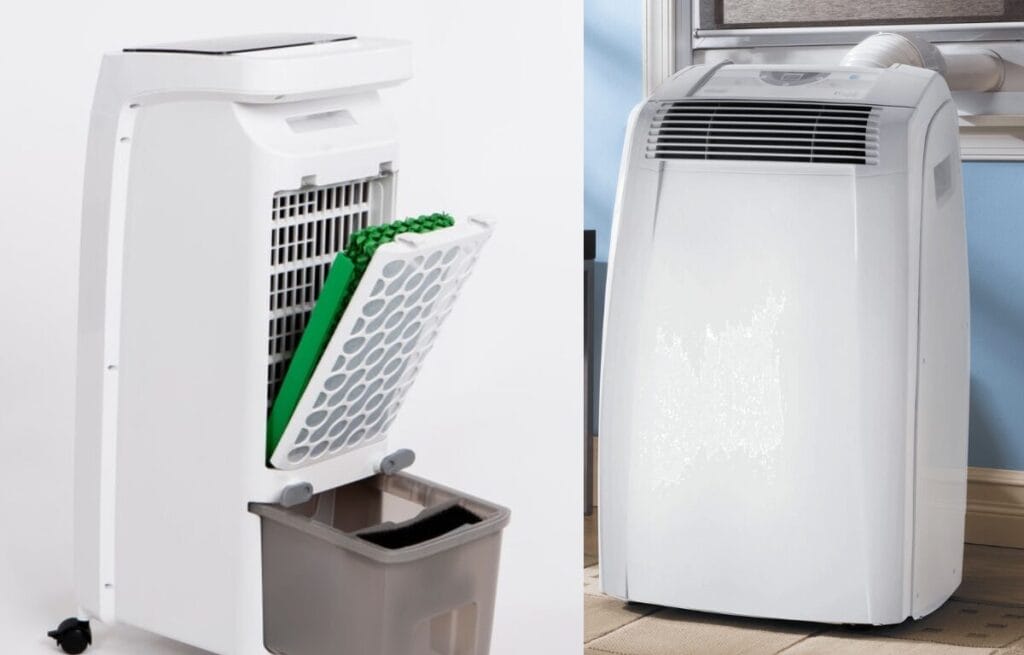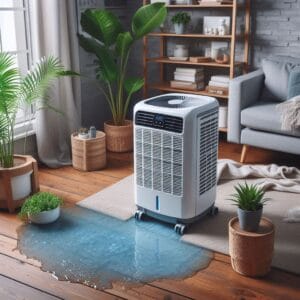A portable AC cools down your space by transferring heat from inside to outside. The portable AC unit extracts hot air from the surrounding environment with an exhaust fan. Inside the air conditioner, hot air flows through evaporator coils, which contain refrigerant. This refrigerant cools down the air by absorbing heat. This cooled and dehumidified air returned to the room and the heat which was absorbed by refrigerant, was transmitted to condenser coils to release outside the room through an exhaust hose.

How does a portable air conditioner work?
Portable air conditioners work like central air conditioners, but these are compact and more cost-efficient. Portable air conditioners are suitable for cooling small rooms or particular areas. Many individuals find it tempting to buy one for their homes, particularly for attics, little independent rooms, and private offices. They are simple to install, relocate, and maintain. They are also highly effective, and portable heat pumps are capable of being used throughout the year!

In this post, I am going to talk about the ways how do portable Air conditioner works. Including single and dual-hose versions. Besides this, we’ll discuss other FAQs, like “Do all portable AC units need to be drained?” or “How many watts of a portable Air Conditioner?”
Do I need to drain my Portable Air Conditioner?
Whether you need to drain your portable air conditioner depends on the AC unit model you have. There are two types of portable air conditioners

Traditional portable AC: These types of portable Air Conditioners require draining. As the AC unit cools the air, it evaporates hot air from coils and removes moisture, which condenses and collects in the drain tub. This collected water needs to be drained from the drain tub regularly, typically every 8 hours to a week, depending on humidity and your usage.
Self-Evaporative Portable AC: This type of AC does not require draining in most cases. They use a process to evaporate the collected condensate, so draining is unnecessary. This is a convenient option, but this evaporation process uses extra energy and if the humidity is too high, they may not be able to evaporate all the condensate, and some dripping may still occur.
What happens if you don’t drain portable AC water?
If you don’t drain portable AC water then the below complications could happen

Shut-off issue: if you don’t drain your portable AC then the most common issue that you can face is that your portable air conditioner will be turned off and not turned back on. This happens because most portable air conditioners have a built-in float switch. The float switch turns off the portable AC when the condenser tank fills up with water. Usually, a portable air conditioner has an alarm system that alerts you, it’s time to drain the tank.
Tank Overflow: If the portable air conditioner’s float switch is out of order or the portable air conditioner does not have a float switch, then tank overflow chances will increase. This is not a big problem, except that there is a chance of water damage to your home.
Mold growth: Mold growth can happen when the portable AC is not emptied properly. A lot of people don’t agree that mold can grow in their AC. If water is not drained properly then it will create moisture which is helpful for mold colonies to grow insight portable AC.
How do I know if I need to drain my portable AC?
There are two main ways to tell that you need to drain your portable ac
1-Checking the indicator: Most portable air conditioners, especially those that require manual draining, have built-in full tank alarms or lights. This will keep you alert when the water container is full and needs to be emptied. The portable AC unit will also shut off to prevent overflow.
2-Observe usage and consult the manual: It is also compulsory to observe your usage and consult the portable air conditioner’s user manual. The draining frequency depends on the humidity level and how often the unit is being used. In general, in high humidity and frequent use, draining will be required more often.
Also, refer to the user manual for specific instructions and guidelines for draining. The user manual will advise you how often you need to drain your portable air conditioner based on its model design and capacity.
Below are my extra tips:
Hear the Gurgling Noise: Most of the users complain about the gurgling noise that they ever experience from the portable air conditioner, think regardless of something is weird, but they are unable to find it out so when you see if there is a gurgling noise, so it means that your water container is full, and it is required to drain it now. Even if you do not hear any alarm or gurgling noise, it is best that you go and check the water container tank every now and then especially when the air is of high humidity.
Why do Portable AC units have to be drained?
All portable air conditioners must be drained, an auto evaporating feature is part of most portable AC units, however, this model possesses an auto evaporation system or continuous drainage function. Manual Drain a portable air conditioner model like that, that will be very light many portable AC tools like that need the collected water to be exhausted personally.
How often should I empty water from my portable air conditioner?
It depends upon the humidity and temperature of your space. Generally, portable air conditioners should be drained after every 8 hours. Removing humidity is an essential part of the cooling process, when first installing a portable AC unit that has not been used for a while, it is normal to fill the water tank too quickly and require frequent emptying. Even once an hour can be normal in this situation.
How Do No Drain Portable Air Conditioners Work?
Self-evaporating or No-drain portable air conditioners. They provide an easy way to cool small spaces without the burden of emptying a drip pan. Portable air conditioners gather air to remove moisture and cool down the air. This moisture then condenses on the evaporator coil that is within the unit. In traditional portable AC, this condensate collects in a drip pan, which must be emptied occasionally. In a Self-evaporating portable AC, the condensate is pumped into a special compartment where it is heated. The heat causes the condensate to evaporate, and the evaporated moisture is then expelled through the exhaust hose along with the hot air. This condensing process uses additional energy and makes the unit less effective overall.
Does Portable AC use a lot of Electricity?
Yes, Portable air conditioners use a lot of electricity. Some portable AC units use electricity more than a Windows AC. The electricity intake depends on the size and power of your portable AC unit. Some aspects affect electricity costs like the size of your area, temperature variation, and insulation.
Do Portable AC use more Electricity?
There are some major reasons why portable air conditioners use more electricity. A large space needs a powerful AC unit, which will use more electricity. Temperature variation is also a big factor in electricity consumption. The variation between room temperature and your desired temperature forces the AC unit to work harder and use more electricity. Poorly insulated places also force the AC unit to work hard and use more electricity to maintain the desired temperature.
How many Watts is a Portable Air Conditioner?
A standard portable AC unit uses 1200–1500 watts. The portable AC is usually 2800–4200 watts per hour, but there are also some available at as low as 340 watts like Coolzy-Go portable AC. Also, there are some Mini Portable AC’s available in the market for small spaces, they are compact and come in the power range of 8 watts to 100 watts.
Is it worth buying a Portable Air Conditioner?
A portable air conditioner is a great choice for small spaces, but it depends on your needs. It has its pros and cons. Portable AC can cool a room or office effectively, but it struggles in large spaces. Portable AC does not require any kind of installation, you can set it up by yourself. You can move it from room to room as required. Most portable AC units require a window for venting hot air, which can block the window or can be caused to break the security.
What are the pros of a Portable Air Conditioner?
Below are the most common pros of a portable AC.
Cools a single room effectively: The portable AC can cool down a single room, small basement, or office perfectly.
Easy to install: The portable AC unit does not require professional installation. Anyone can set it up by himself.
Cost-effective: They are more cost-efficient than central air conditioners. Portable AC’s are the best performers in small areas, and they are also cost-effective.
Portables: The best advantage of a portable AC unit is that you can shift it from room to room according to your needs without any professional installation.
Dehumidification: Some models of portable AC came along with humidity control with cooling.
What are the Cons of a Portable Air Conditioner?
Besides that portable AC units are cost-effective and easy to install, they also have some cons which we can’t ignore
Large space efficiency: it works perfectly in small areas, but when it’s about large spaces, it struggles to cool large spaces or big rooms.
High operating cost: Portable AC units typically range from 2800 to 4500 watts per hour. So, they will use a lot of electricity and can raise electricity bills.
Noisy: The portable AC can be disruptive, especially in a bedroom.
Less efficient cooling: Portable AC units don’t cool as effectively as central air conditioning.
Window venting: A portable AC unit requires a window for venting hot air. Sometimes it could be difficult to shift a portable AC unit from one room to another due to the unavailability of window venting in another room.
Conclusion
Overall, portable AC is a good option for cooling a small and well-insulated space. It is also good for supplemental cooling in a room with poor central air conditioning. It is also best if you are on rent, and can’t install permanent fixtures. But if you want to cool your entire home or a large space for the long term then the portable air conditioner may not be the economical or effective solution.
